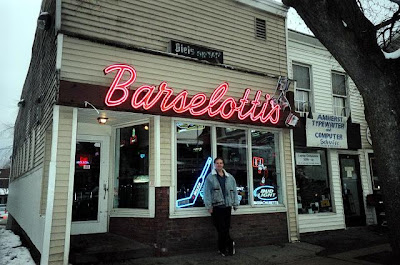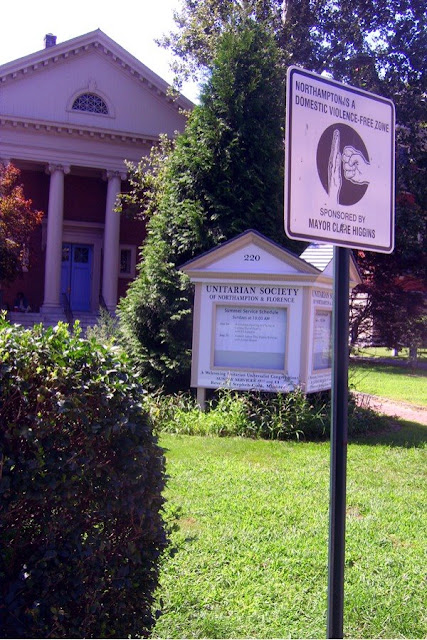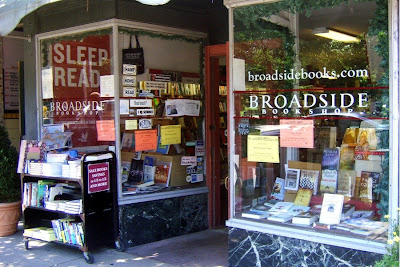Why Albano's arts and entertainment district has failed.
In this photograph of the cover of The Baystate Objectivist, you can see in the left hand corner a picture of me, age twelve, wearing a StarTrek shirt.

I keep reading, particularly in the Union-News, about a new cultural renaissance taking place downtown. For years the center of the music and arts scene in the Valley has been Northampton. In fact most of the major cultural events in the Valley seem to bypass Springfield entirely. Whenever local bands went national (Dinosaur Jr. comes to mind) they would go directly from their success in the Northampton area to the Boston markets and beyond. It was never considered essential to have an interim phase of conquering the Springfield market.
As the larger, more populous and diverse city, Springfield seems as if it should be the natural leader of the region's cultural scene. Yet the consensus in recent decades has been that culturally Springfield is the poor cousin to its smaller neighbor to the north.
It wasn't always so. From the 1800's right up through the 1950's Springfield was renowned in the arts and entertainment world for its unusually sophisticated and challenging audiences. From Twain and Dickens to Elvis and The Grateful Dead, few major figures in the arts left Springfield off their itinerary. In recent decades however, little has seemed to work very well for Springfield in the cultural arena.
The terminally deficit ridden Springfield Civic Center long ago lost its status as the region's premier venue for top talent to Hartford and then later, The Mullins Center. StageWest suffers from chronic financial difficulties, as does the city's symphony. The Quadrangle, arguably the city's cultural heart, faces charges of elitism and dominance by wealthy suburbanites who sometimes act like the Quadrangle is just their personal hobby.
As for the music scene, it was long considered to be virtually non-existent, with most city clubs either not hiring live acts or booking so-called "tribute" bands which play already popular songs by already well known groups. Shamefully, it was necessary for Springfield bands that played original music to abandon their home city for Northampton.
All that started to change a year or so ago. One of the unintended side effects of the success of the Northampton scene was that as Northampton became more and more famous as a cultural mecca, it also became more and more competitive and as a result, more expensive as a place to survive as a business. As real estate values soared, those being priced out were the kind of low rent inexpensive venues that are essential to nurturing start-up cultural enterprises.
Meanwhile, in Springfield, whose Main Street was unable to support even a Friendly's or the Johnson's Bookstore, there is plenty of cheap affordable property, especially on the destitute side streets off of Main, where desperate landlords rent space at bargain prices. Gradually, those who felt frozen out by the high rents and stiff competition in Northampton began migrating south to occupy the all but abandoned real estate in downtown Springfield.
The new businesses cater to a previously untapped market in the Springfield area. It's often said that part of the reason for the Northampton area's success is the five major colleges in its vicinity. Springfield however has four colleges in a much more condensed area. Many of these Springfield students used to travel to Northampton on the weekends, but now they go to the downtown arts and music clubs, many of which are without liquor licences and cater especially to an 18-20 year old clientele.
It's possible to attract a sizable crowd from Springfield College, Western New England, Springfield Technical Community, American International College and even the nearby Elms. In other words, there was this huge entertainment market that nobody was serving, and so, like a daisy coming up through the asphalt, the ruins of downtown's failed 1980's revitalization became the playground for thousands of Springfield college students and entrepreneurs in exile from the prohibitively expensive Northampton market.
As the crowds increased, the predictable synergistic effects occurred. Successful businesses attracted other, similar businesses, some of them more upscale than the first pioneers. Restaurants and coffee houses began popping up in long abandoned storefronts while streets long considered lonely and dangerous became crowded and well lit by commercial signs. The heart of the revitalization is the area immediately surrounding Stearns Square, but the positive effects can be felt throughout the downtown area. The word is starting to spread. For the first time in years, downtown Springfield is a place worth exploring after dark.
Not content to merely read about these developments, I embarked on a tour of this new entertainment district myself. I stopped in at the Life in Harmony Cafe, a kind of hippie-style salon, visited the DNA Club, Fat Cats and Caffeine's, the latter being probably the most upscale of the Worthington stops (valet parking no less) but it is still designed to fit in with their more modest neighbors.
I spent a wonderful evening as the old man in residence at a place called Daddy-O's, whose packed to the wall crowd of almost exclusively under 20 year olds rocked with such youthful exuberance that I was jealous that no such club existed to for me to attend when I was their age. A few remnants remain in the area from the bad old days, in particular a shabby porno shop and a fortune telling parlor, but their days appear to be numbered.
For one of my visits to the new entertainment district I decided to see what the scene was like on a non-weekend night. Not surprisingly, I found the area much less active but still far from deserted. I spent a little time sitting on a marble bench in Stearns Square, watching the passerby, and recalled how when I was a high school student I used to cut across Stearn Square after school while en route to that temple to misspent youth, Playtown. I tried to remember what this section of town had been like in those days but couldn't clearly recall.
It isn't just young peple and patrons of fine dining who have noticed that daisy coming up through the asphalt downtown. Last month Mayor Albano announced that we now have a new and completely official ARTS AND ENTERTAINMENT DISTRICT complete with official maps and official charts and official government programs designed to create what the maps and charts and government programs say they'll create. Nevermind that this district has already come into being without the help of City Hall. Nevermind that none of those who started this district ever asked for government help - and probably wouldn't have received it if they had. Nevermind the very relevant questions of whether the city's economic planners are even competent to design, or should be allowed to dictate, what this district should be like. The fledgling, still fragile arts and entertainment district is approaching its hour of greatest peril. The government has arrived, announcing, "We've come to help you."
For all the media attention the Mayor's announcement got, it was actually pretty short on the specifics of what the city intends to do. There was vague talk about "encouraging" new businesses with low interest loans, creating "standards" for the district and the predictable happy talk about how the new bigger Civic Center will somehow be more successful than the failed current one and how the still non-existent revitalized riverfront will send its overflowing crowds into downtown.
But as imprecise as Mayor Albano's remarks were, the general thrust of his proposal is fraught with danger. Most ominously, the plan seems oblivious to the forces that brought the district into existence in the first place. It was the desire of the business community to find and create an environment that was looser, cheaper and less structured than could be found in overdeveloped Northampton that brought the first entrepreneurs to the area. If the district becomes some kind of rigid, perfectly planned government supervised economic development project, the spontaneous, free market atmosphere that currently gives the district its appeal will soon evaporate.
Another key component of the district, reasonable rents, is also placed at risk by the city's plan. What could drive up rents quicker than to have the government involved in placing businesses into these buildings with the subsidy of cheap loans? And who, precisely, would be receiving these loans? Will it be people like those who created the Life in Harmony Cafe or Daddy O's? Or will it be already established businessmen, especially those with political connections?
It's no secret that powerful insiders are already beginning to maneuver within the district. Peter Picknelly, for example, is planning to do something with the old Zeller building. When someone like Picknelly becomes involved, then you know that the city's inside players have arrived big time.
It's a shame to see the city's economic development glitterati becoming involved. Their almost unbroken string of failures - Monarch Place (at one point sold to its creditors for one dollar) the Bank of New England building (no one wants to remember the Bank of New England) the Hollywood revitalization project (which tranformed a merley poor neighborhood into a full blown ghetto) Indian Motocycle apartments (they thought people would want to buy condominiums in the slums) the Plaza del Mercado - on and on over the years until our economic planners acquired their well deserved reputation for poisoning everything they touch. Now that they want to get their grubby little paws all over the fledgling arts and entertainment district and I predict they will kill it if they do.
But I'm a reasonable man, and I understand that our economic planners have to do something to justify their 60, 70 and 80 thousand dollar salaries. I mean just because a cultural and financial renaissance blossomed downtown without their participation or even their awareness doesn't mean that they shouldn't come muscleing in on the action now that others have got the district up and running. Let's allow them to proceed according to the following three step plan (they love multi-step plans) as a guide for them to follow whenever they feel the need to do something for the arts and entertainment district:
Step Number One: Leave the district alone.
Step Number Two: Do nothing.
Step Number Three: Go away.
What's happening around Stearns Square is a miracle. A key section of the city that was given up for dead just a few years ago is coming back to life, with nothing but the free market and the creativity of the participants guiding its development. City Hall can only impede its growth with its interference. Didn't we learn anything from the 1980's when we tried to direct the development of downtown from City Hall and instead ended up with a ghost town? Let the district evolve according to its own pace, in its own way and in accordance with what the market will support. Anything else will be artificial, and artificiality is death in both business and art.

Walking across Stearns Square, I paused for some reason by the Square's famous fountain, which was built by the same guy that made the puritan statue at the Quadrangle. It was a mess. Rainwater had gathered in the fountain basin and papers and McDonald's soda cups and beer cans were floating in it. It occurred to me that if the city really wanted to be helpful to the arts and entertainment district they could start by doing a little routine maintenance on the city's property.
Then I was struck by an odd thought. Hadn't there once been statues of turtles here? Around the fountain? I couldn't remember whether I had actually seen such turtles myself or merely noted them in photographs of Stearns Square back in the day. I saw a couple of block-like stumps that looked like that's where they might once have been, but I couldn't be sure. I surprised myself by saying out loud, though there was no one around, "Where's the fuckin' turtles?"
I started walking and I found myself walking faster and faster because suddenly it seemed necessary to walk fast, fast, fast because it was cold, cold, cold and so very, very late and then I looked up and had to blink something out of my eyes to see that there was a full moon overhead.
Flashback: Doyle the Twig Painter and Yvonne Gordon in 1994.
I came across this Flickr series called A New World that features some photos taken in Northampton in 1985:
A Valley cowboy at dusk.

To see the complete set of photos click here.
Did you know there's a video about Barsies, the bar whose closing in 2006 broke the heart of Amherst like nothing since they shut down The Drake?
The liner notes to this loving tribute to Barsie's has this to say:
The legendary Barselotti's bar, better known by generations of customers as Barsies. Located in the heart of downtown Amherst, MA , this college town attraction has been a popular watering hole for nearly 75 years. Many students from the five college area (UMASS, Amherst College, Hampshire College, Mount Holyoke College & Smith College) have spent time in this establishment during their college years. Once referred to as "the dirty little drunken school bus" Barsie's has been a mainstary in the "Happy Valley" since 1933.
I was never much of a Barsie's patron. It was always very much a straight people's pick up bar, and not a good place to go if you were openly queer. They did however hire cute bartenders.

I mostly remember Barsies as being full of drunken fratboys, girls with big tits and "Shook Me All Night Long" playing on the jukebox over and over until it gave you a headache. Just sayin.






















































